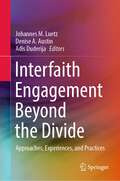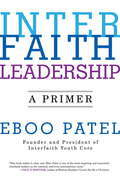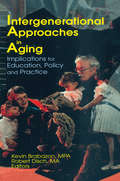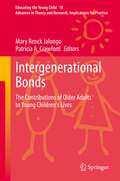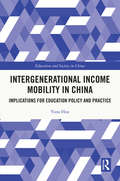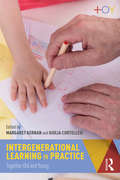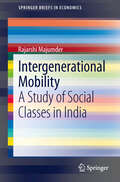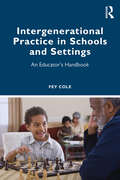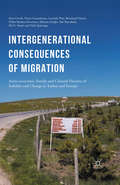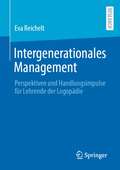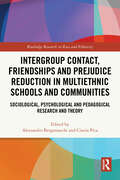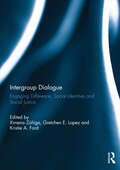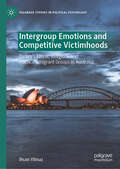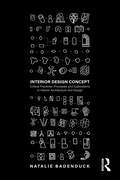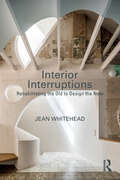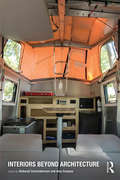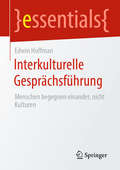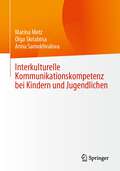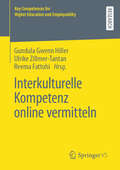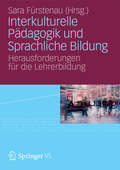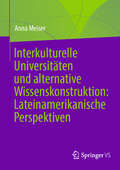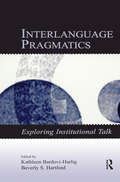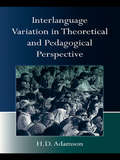- Table View
- List View
Interfaith Engagement Beyond the Divide: Approaches, Experiences, and Practices
by Adis Duderija Johannes M. Luetz Denise A. AustinThis book features reflections by scholars and practitioners from diverse religious traditions. It posits that the global challenges facing humanity today can only be mastered if humans from diverse faith traditions can meaningfully collaborate in support of human rights, reconciliation, sustainability, justice, and peace. Seeking to redress common distortions of religious mis- and dis-information, the book aims to construct interreligious common ground ‘beyond the divide’.Organised into three main sections, the book features sixteen conceptual, empirical, and practice-informed chapters that explore spirituality across faiths and cultures. Chapter 1 delineates the state of the art in relation to interfaith engagement, Chapters 2–8 advance theoretical research, Chapters 9–12 discuss empirical perspectives, and Chapters 13–16 showcase field projects and recount stories and lived experiences.Comprising works by scholars, professionals, and practitioners from around the globe, Interfaith Engagement Beyond the Divide: Approaches, Experiences, and Practices is an interdisciplinary publication on interreligious thought and engagement:Assembles a curated collection of chapters from numerous countries and diverse religious traditions;Addresses interfaith scholarship and praxis from a range of interdisciplinary perspectives;Comprises interfaith dialogue and collaborative research involving authors of different faiths;Envisions prospects for peace, interreligious harmony in diversity, and a world that may be equitably and enduringly shared.The appraisal of present and future challenges and opportunities, framed within a context of public policy and praxis, makes this interdisciplinary publication a useful tool for teaching, research, and policy development. Chapter 16 is available open access under a Creative Commons Attribution 4.0 International License via link.springer.com.
Interfaith Leadership: A Primer
by Eboo PatelA guide for students, groups, and organizations seeking to foster interfaith dialogue and promote understanding across religious linesIn this book, renowned interfaith leader Eboo Patel offers a clear, detailed, and practical guide to interfaith leadership, illustrated with compelling examples. Patel explains what interfaith leadership is and explores the core competencies and skills of interfaith leadership, before turning to the issues interfaith leaders face and how they can prepare to solve them. Interfaith leaders seek points of connection and commonality--in their neighborhoods, schools, college campuses, companies, organizations, hospitals, and other spaces where people of different faiths interact with one another. While it can be challenging to navigate the differences and disagreements that can arise from these interactions, skilled interfaith leaders are vital if we are to have a strong, religiously diverse democracy. This primer presents readers with the philosophical underpinnings of interfaith theory and outlines the skills necessary to practice interfaith leadership today.
Intergenerational Approaches in Aging: Implications for Education, Policy, and Practice
by Robert Disch Kevin BrabazonIn Intergenerational Approaches in Aging: Implications for Education, Policy, and Practice, leading practitioners and academics from a variety of disciplines come together to discuss theoretical issues, current practice, and future directions for this rapidly developing field. The authors address key topics such as defining the intergenerational field, the effects of the segregation of groups by age on social function and organization in our communities, and designing, implementing, and assessing programs that create cross-generational connections. Exploring ways to provide services to different age groups while tapping the strengths and skills of each age group, Intergenerational Approaches in Aging examines the application of intergenerational approaches to important social issues as well as specific challenges faced by practitioners. It makes suggestions for integrating intergenerational studies into the higher education system and for challenging segregated services and funding programs. As the book shows, promoting cooperation between diverse segments of society also depends on:making intergenerational programming a permanent feature of public schoolsunderstanding and meeting the social, mental health, and medical needs of grandparents who are raising their grandchildrenusing observational research to study and evaluate intergenerational program effectiveness and the relationships among the people involvedviewing differences among people as assetsdeveloping intergenerational program modelsproviding children with a 'life-cycle’view of the worldIntergenerational Approaches in Aging offers the personnel of state and local agencies on aging, nursing homes, senior centers, and geriatric homes practical advice, innovative ideas, and supportive materials for developing and implementing intergenerational activities and programs that can benefit all parties involved. Academics and school administrators will also benefit from this book as they learn concrete methods for integrating aging education into already existing curricula and building new conceptual frames of reference for a wide variety of social issues and historical topics.
Intergenerational Bonds: The Contributions of Older Adults to Young Children's Lives (Educating the Young Child #18)
by Mary Renck Jalongo Patricia A. CrawfordThis book studies the many different ways in which the lives of the first, third, and fourth generations intersect and the reciprocal benefits that can accrue from establishing positive intergenerational bonds. The unifying feature across the chapters is that the authors view these relationships as a powerful influence on Quality of Life (QoL). The book takes the stance that older adults figure prominently in the QoL of young children, with the latter group defined here as ranging in age from infancy up to and including eight years of age. It examines how bonds with older adults can affect young children’s functioning across developmental domains—physical, emotional, social, and cognitive. It addresses questions of importance to those who have a commitment to the very young such as: “What benefits can young children derive from positive bonds with older adults?”, “How do young children understand the aging process and develop respect for the elderly?”, “How can published research be used to guide both informal and formal interactions between the older generation and the newest one?” and, finally, “How can various stakeholders such as professionals, families, organizations, and communities collaborate to enrich and enlarge the kind and amount of support that older adults provide to the very young child?”
Intergenerational Income Mobility in China: Implications for Education Policy and Practice (Education and Society in China)
by Yuna HouIntergenerational income mobility is of great societal importance due to its relevance to equal socio-economic opportunity and future economic efficiency. In her book Dr Hou explores the potential role of education policy in reducing intergenerational transmission of poverty and promoting intergenerational income mobility in China. Her research investigates the extent to which intergenerational income persists in China, the mechanisms behind intergenerational inequality, and premises for policy intervention. The interaction between families, labour markets, and public policies that structure a child’s opportunities and determine the extent to which income is related to family background are discussed in detail. The book comprises of three separate empirical studies examining the relationship between parents’ income and the long-term welfare of their children for two birth cohorts; the role education plays in the intergenerational income relationship; and possible policy intervention channels to facilitate intergenerational income mobility. The lessons learnt from the empirical studies in this book offer the basis for a discussion of current educational policies and provide guidance for developing more appropriate public policies to promote intergenerational income mobility in China in the future. This book contributes to the international discussion by providing evidence in Chinese context, and also provides guidance for policymakers attempting to develop more appropriate public policies to promote intergenerational income mobility in China.
Intergenerational Learning in Practice: Together Old and Young
by Margaret Kernan Giulia CortellesiBased on innovative global practice, Intergenerational Learning in Practice presents a unique contribution to the field of intergenerational learning. Drawing on the Together Old and Young (TOY) programme, this book provides a comprehensive background to intergenerational learning, along with tools and resources to help develop and improve your own intergenerational practice. Experienced international authors from Europe, North America and Australia provide a broad array of perspectives on intergenerational learning, ranging from pedagogy to planning and community development, and cover topics including: The context, theory and existing research behind intergenerational learning The changing relationships between young children and older adults Building communities and services for all ages Managing everyday encounters in public spaces between young and old Ensuring quality in intergenerational practice Insights on how intergenerational learning challenges discrimination Intergenerational Learning in Practice is a valuable resource for practitioners and leaders in Early Childhood Education and Care and those working in primary schools, as well as professionals caring for older adults, and those working in community development.
Intergenerational Mobility
by Rajarshi MajumderDiscrimination and exclusion in the process of capability formation and the labor market transcend the boundaries of the current generation and spill over to successive generations as well. Though a plethora of work has been done at the international level, the area has not been the focus of Indian economic research despite social exclusion and disparity having been quite substantial in India, especially the division along caste lines. The book addresses this research gap and explores the issue of intergenerational mobility across different social classes in the Indian context, analyzing the spheres of both education and occupation. We contend that parental education and occupation have a significantly greater impact on educational attainment and occupational choice for socially excluded groups compared to the advanced groups. In the labor market, intergenerational mobility is low and most of it is lateral and not vertical, increasing the possibility of discrimination in the labor market. This book highlights the fact that the long history of social exclusion has had a lasting effect and it is very difficult to come out of this inertia.
Intergenerational Practice in Schools and Settings: An Educator’s Handbook
by Fey ColeIntergenerational Practice in Schools and Settings provides guidance through the many approaches in education that bring generations together. Identifying the purpose of intergenerational practice, this book offers an insight into how other educational settings have used programmes to enhance the learning experience and connect students to their community and local environment. Serving as a practical guide on setting up an intergenerational programme and identifying how to overcome the barriers that educators may face as they progress, this engaging book provides the knowledge and skills needed for developing sustainable projects and provides students with the opportunity to enhance the world around them. With case studies from a range of educators and practitioners, this book encourages readers to reflect on how to establish multi-agency relationships to create mutual learning spaces for different generations. Intergenerational Practice in Schools and Settings is an accessible text to understand the evidence behind the approach, with experiences from educators who are fully engaged with intergenerational practice. It is an inspirational guide for experienced educators, trainee students interested in adopting an intergenerational approach, and for those with prior experience in the field, providing a rationale of how to develop and extend intergenerational opportunities.
Intergenerational consequences of migration: Socio-economic, Family and Cultural Patterns of Stability and Change in Turkey and Europe
by Helen Baykara-Krumme Lucinda Platt Niels Spierings Ayse Guveli Bernhard Nauck Şebnem Eroğlu Sait Bayrakdar Efe K. Sözeri Harry Ganzeboom Sebnem ErogluThis book analyzes the impact of migration on the lives of multiple generations of 2000 Turkish families. Exploring education, marriage, fertility, friends, attitudes and religiosity, it reveals transformations and continuities in the lives of migrants and their families in Europe when compared to their non-migrant counterparts in Turkey.
Intergenerationales Management: Perspektiven und Handlungsimpulse für Lehrende der Logopädie
by Eva ReicheltDie Zusammenarbeit der Generationen ist eine stetige Herausforderung, so auch in der therapeutischen Ausbildung der Studiengänge für Logopädie. Lehrende treffen hier regelmäßig auf neue Generationen, die charakteristische Verhaltensmuster und Werthaltungen einbringen. Der jüngsten Generation, der „Generation Z“, werden hohe Erwartungen an Lehrende und Arbeitgebende zugeschrieben. Sie möchte auf Augenhöhe mitbestimmen und ist sich der Tatsache bewusst, dass sie aufgrund des wachsenden Fachkräftemangels auf dem Arbeitsmarkt gebraucht wird. Zur Vermeidung von Ausbildungsabbrüchen ist eine bewusste Antizipation im Hinblick auf ihre Anliegen und Herausforderungen erforderlich. Zeitgleich soll die Entwicklung zu kompetenten und verantwortungsbewussten Therapeut*innen gelingen. Das hier vorgestellte intergenerationale Management ist handlungsorientiert und liefert neue Impulse für reflexives und lösungsorientiertes Handeln für Lehrlogopäd*innen.
Intergroup Contact, Friendships and Prejudice Reduction in Multiethnic Schools and Communities: Sociological, Psychological and Pedagogical Research and Theory (Routledge Research in Race and Ethnicity)
by Alessandro Bergamaschi Cinzia PicaThis edited collection addresses the important study of the conditions that support positive intergroup contact that leads to intergroup friendships and prejudice reduction through a multidisciplinary lens. Employing Intergroup Contact Theory and Intergroup Friendships Theory as conceptual foundations, this book brings together researchers in psychology, sociology and education.European societies are increasingly diverse spaces in which children, adolescents and adults of different racial and ethnic backgrounds, religious beliefs and cultural-linguistic practices interact daily. These spaces provide fertile ground for a continuum of relational experiences, from positive intergroup relationships and friendships to tensions and experiences of discrimination, marginalization and isolation. Bergamaschi, Pica and their contributors examine the psychological and sociological conditions, as well as the pedagogical interventions, that can shape interactions among young people.The book will be of great interest to academics and students across disciplines, educators, policy makers and activists interested in how to support intercultural societies and schools toward the goal of reduced prejudice and discrimination toward a more intercultural and just society. The book will be a valuable read for scholars of the sociology of multiethnic society and for scholars interested in the role of education and school environments.
Intergroup Dialogue: Engaging Difference, Social Identities and Social Justice
by Ximena Zúñiga Kristie A. Ford Gretchen E. LopezIntergroup dialogue is a form of democratic engagement that fosters communication, critical reflection, and collaborative action across social and cultural divides. Engaging social identities is central to this approach. In recent years, intergroup dialogue has emerged as a promising social justice education practice that addresses pressing issues in higher education, school and community settings. This edited volume provides a thoughtful and comprehensive overview of intergroup dialogue spanning conceptual frameworks for practice, and most notably a diverse set of research studies which examine in detail the processes and learning that take place through dialogue.This book addresses questions from the fields of education, social psychology, sociology, and social work, offering specific recommendations and examples related to curriculum and pedagogy. Furthermore, it contributes to an understanding of how to constructively engage students and others in education about difference, identities, and social justice.This book was originally published as a special issue of Equity & Excellence in Education.
Intergroup Emotions and Competitive Victimhoods: Turkey’s Ethnic, Religious and Political Emigrant Groups in Australia (Palgrave Studies in Political Psychology)
by Ihsan YilmazThis book examines the narratives and collective emotions of diaspora groups who originate from Turkey and now live in Australia, focusing on their experiences of collective victimhood, competitive victimhood, and intergroup emotions in relation to other diaspora groups from Turkey. Based on 122 semi-structured extensive interviews with Armenians, Kurds, Alevis, Gülenists, Kemalists and Erdoğanists, the book argues that, while in power, dominant groups driven by competitive victimhood often exhibit indifference toward the victimhood of other groups. This dynamic reflects how ressentiment can perpetuate cycles of oppression and antagonism. However, this pattern can shift when powerful groups find themselves in opposition. In such scenarios, they may become more attuned to the grievances of other groups.
Interior Construction Installer: Passbooks Study Guide (Career Examination Series)
by National Learning CorporationThe Interior Construction Installer Passbook® prepares you for your test by allowing you to take practice exams in the subjects you need to study. It provides hundreds of questions and answers in the areas that will likely be covered on your upcoming exam.
Interior Design Concept: Critical Practices, Processes and Explorations in Interior Architecture and Design
by Natalie BadenduckInterior Design Concept combines a comprehensive introduction to design concept, with a reflective examination upon the various ways it can be understood, harnessed, and implemented. Within interior architecture and design, the power of conceptual thinking to fuel creativity, innovation, and collaboration is evident in the use of design concept. Broadly accepted as an essential component in the design process, design concept is a notoriously elusive topic which has, until now, received little critical attention. This book offers a reevaluation of current academic ideas about design methodologies and the nature of inspiration, alongside brand-new data from an international research study to help clarify what creativity really means in the modern world. Topics addressed throughout this text will examine the functions and definitions of design concept, analyze how it may be identified and integrated within the design process, investigate from where ideas for design concepts can emerge and, lastly, consider how ideas about them might be communicated in various ways. This book offers students, educators, and practitioners a concise explanation of what design concept is, why it plays such an integral role in the design process, and how it is utilized by interior architects and designers.
Interior Design: A Global Profession
by Roderick AdamsAs the globe shrinks and the concept of distance diminishes, this text challenges the current status quo by identifying the cohesions and specialisations of design communities across the continents. It sets out an international spatial design landscape, identifying and contouring global design practice and design hotspots from a range of case studies, interviews and design practice perspectives. Using a range of interior environments, the chapters link the origins, trends and perceptions of the interior to create new insight into trans-global design. The book expands, but also coheres the interior design discipline to ensure the subject continues to grow, develop and influence the inhabitations of the world. The book features a wealth of pedagogical elements including: Beautifully designed with over 100 full colour illustrations, photographs and examples of design work Maps and diagrams which highlight hotspots of design across the globe, providing strong graphic information Interview panels featuring professional insights from designers across the globe ‘Employability’ boxes, providing a good tips guide for students gaining employment across the globe ‘International Dimension’ boxes which strengthen the scholarship of studying interior design in a globalised way ‘Design Oddities’ box which brings into focus any new or contextual facts that help contextualise the global interior.
Interior Interruptions: Rehabilitating the Old to Design the New
by Jean WhiteheadInterior Interruptions examines the role of the ‘palimpsest’ and its relationship to narrative, sustainability, renovation and adaptive reuse. By exploring storytelling, palimpsestic characteristics and techniques, the book argues that these devices play a central role in the consideration of the designed interior.Narrative has a burgeoning relationship with the palimpsest and this approach embraces an aesthetic of incompleteness and imperfection as a site rich response. It recognises the ongoing ‘biography’ or heritage of a building as a form of transient architectural narrative that encourages reuse through the continual process of writing, rewriting, overwriting and unwriting. This process has sustainable, societal, archaeological and textual connotations that can be interpreted as a process of ‘layering’ whereby the architectural shell is viewed as a container; a rich repository that is ‘overlain’ by surface changes, documents architectural and spatial modifications, and is populated by interior fixtures and fittings that all unite to create an ever-changing interior story.Exploring case studies from the UK, Netherlands, Palestine, Belgium, Singapore, Spain, Portugal, France, Germany, Brazil, Japan, USA and China and beautifully illustrated in full colour, this book proposes that the act of interior renovation can be viewed as a perpetual form of revisionary storytelling re-imagined as a series of temporal interior ‘interruptions’. It is essential reading for students and professionals interested in the built environment, including, but not limited to, interior design, interior decoration, interior architecture and architecture.
Interiors Beyond Architecture
by Deborah Schneiderman Amy CamposInteriors Beyond Architecture proposes an expanded impact for interior design that transcends the inside of buildings,?analysing significant interiors that engage space outside of the disciplinary boundaries of architecture. It presents contemporary case studies from a historically nuanced and theoretically informed perspective, presenting a series of often-radical propositions about the nature of the interior itself. Internationally renowned contributors from the UK, USA and New Zealand present ten typologically specific chapters including: Interiors Formed with Nature, Adaptively Reused Structures, Mobile Interiors, Inhabitable art, Interiors for Display and On Display, Film Sets, Infrastructural Interiors, Interiors for Extreme Environments, Interior Landscapes, and Exterior Interiors.
Interkulturelle Gesprächsführung: Menschen begegnen einander, nicht Kulturen (essentials)
by Edwin HoffmanWir alle kommen mit der Superdiversität der Gesellschaft in Kontakt, die zeigt, wie geschichtet, kontextabhängig und veränderlich sich Menschen sozial organisieren und identifizieren. Kulturelle Identität ist schon lange nicht mehr nur mit der nationalen Herkunft identisch, Autochthone und Migranten aus zahlreichen Herkunftsländern haben jeweils ihre eigene Vielfalt an Bevölkerungsgruppen und sozialen Kategorien. Was bedeutet diese Superdiversität für die professionelle Kommunikation? Edwin Hoffman bietet in diesem essential mit vielen Beispielen einen innovativen Ansatz, der auf zwischenmenschlicher Kommunikation und nicht auf der Begegnung von Kulturen basiert. Das TOPOI-Modell enthält Handlungsstrategien zur Reflexion und Überbrückung von Kommunikationsunterschieden.
Interkulturelle Kommunikationskompetenz bei Kindern und Jugendlichen
by Marina Metz Olga Skriabina Anna SamokhvalovaDas Buch ist für Fachkräfte geeignet, die mit Kindern und Jugendlichen im interkulturellen Kontext arbeiten, Psychologinnen, Pädagoginnen, Erzieherinnen und Lehrerinnen. Das Wissen über die verschiedenen Vermittlungsmöglichkeiten von interkulturellen Inhalten ermöglicht eine bessere Wahl der Kommunikationsformen, um die Kommunikation effektiver, zielgerichteter und respektvoller zu gestalten. Das Buch greift wichtige theoretische Erkenntnisse zur Interkulturellen Kommunikationskompetenz auf, erklärt diese auf eine veranschauliche Weise und gibt zahlreiche forschungs- und praxisrelevante Beispiele.
Interkulturelle Kompetenz online vermitteln (Key Competences for Higher Education and Employability)
by Gundula Gwenn Hiller Ulrike Zillmer-Tantan Reema FattohiBei interkulturellen Trainings geht es um den Erwerb des kommunikativen Handlungswissens sowie die Arbeit an der inneren Haltung. Voraussetzungen dafür sind eine vertrauensvolle Atmosphäre und Interaktion. Wie lässt sich das online umsetzen? Dieses Buch liefert darauf Antworten, in 3 Teilen:• Theoretische Grundlagen vermitteln didaktische Prinzipen • Praxisberichte inspirieren zur Umsetzung innovativer Lehr-Lernkonzepte, und • Eine praxiserprobte Methoden-Sammlung von über 50 Trainer*innen liefert eine breite Auswahl an Tools für interkulturelles Lernen. Trainer*innen und Lehrende finden hier solides handwerkliches Wissen mit konkreten Umsetzungstipps.
Interkulturelle Pädagogik und Sprachliche Bildung
by Sara FürstenauInterkulturelle Pädagogik und Sprachliche Bildung sind Querschnittsaufgaben der Lehrerbildung. Wie können Lehrkräfte und andere pädagogische Fachkräfte angemessen auf den Umgang mit Differenz und Ungleichheit im Kontext sprachlich-kultureller Heterogenität vorbereitet werden? Der Band sammelt Antworten aus einer interdisziplinären Perspektive: Die Beiträge fragen explizit nach Innovationen der Lehrerbildung oder vertiefen ausgewählte Fragestellungen, Konzepte, Forschungs- oder Praxisprojekte, deren Inhalte für eine innovative Lehrerbildung relevant sind.
Interkulturelle Universitäten und alternative Wissenskonstruktion: Lateinamerikanische Perspektiven
by Anna MeiserDie seit rund zwanzig Jahren in ganz Lateinamerika gegründeten „Interkulturellen Universitäten“ erheben gegenüber den Hochschulen euroamerikanischer Tradition den Anspruch einer „alternativen“ Forschung und Lehre. Die Arbeit analysiert, wie solche Universitäten lokale und indigene Wissenstraditionen in Dialog mit „westlichen“ Wissenschaftsdiskursen zu bringen und damit Wissen interkulturell zu konstruieren suchen. Sie zeigt dabei Wege zu einer Dekolonialisierung von Wissenschaft und Hochschulbildung auf, reflektiert die ethnologische Fachtradition und deren methodisches Arbeiten und diskutiert das allgemeine Potential einer Interkulturalisierung von Wissenschaft. Grundlage dieser Analyse sind umfassende Feldforschungen vor allem in Ecuador und Mexiko.
Interlanguage Pragmatics: Exploring Institutional Talk (Second Language Acquisition Research Series)
by Kathleen Bardovi-Harlig Beverly S. HartfordThis volume brings conversational analysis into the study of second language pragmatics as an analytic paradigm. A well-regarded team of researchers addresses a difficult area for the interlanguage pragmatics research community--the balance between experimental method and the use of conversational data. Institutional talk provides authentic and consequential talk. The goal of the book is to demonstrate how the investigation of institutional talk balances the researcher's need for comparable and replicable interactions with the need to observe authentic outcomes. The chapters present empirical studies based on quantitative and qualitative analyses, which are carefully illustrated by the real-world variables that each institution controls. The chapters span a range of institutions, including the university writing center, hotels, secondary schools, and employment offices. The variables examined include the traditional ILP variables, such as status, directness, and social distance, as well as new concepts like trust, authority, equality and discourse style.
Interlanguage Variation in Theoretical and Pedagogical Perspective
by H.D. AdamsonIn this book H.D. Adamson reviews scholarship in sociolinguistics and second language acquisition, comparing theories of variation in first and second-language speech, with special attention to the psychological underpinnings of variation theory. Interlanguage is what second language learners speak. It contains syntactic, morphological and phonological patterns that are not those of either the first or the second language, and which can be analyzed using the principles and techniques of variation theory. Interlanguage Variation in Theoretical and Pedagogical Perspective: relates the emerging field of variation in second language learners’ speech (interlanguage) to the established field of variation in native speakers’ speech relates the theory of linguistic variation with psycholinguistic models of language processing relates sociolinguistic variation theory to the theory of Cognitive Grammar suggests teaching applications that follow from the theoretical discussion At the forefront of scholarship in the fields of interlanguage and variation theory scholarship, this book is directed to graduate students and researchers in applied English linguistics and second language acquisition, especially those with a background in sociolinguistics.
